
What to visit in Heraklion
Crete’s biggest city, Heraklion is a exciting place, full of vitality, noise and traffic routes. The city does have wonderful fortifications, a
fine market, atmospheric old alleys. Virtually everything you’re likely to want to see lies within the northeastern
corner of the walled city. The island's capital and chief port, is full of history and attractions in and around the Old City.
It has a very beautiful waterfront area with seaside restaurants with delicious food, several important museums, and lovely squares where you can easily spend an
afternoon in a street-side cafe. The lively Old City is of most interest to visitors, and it's worth taking some time to
see. In ancient times, Heraklion was the port of Knossos, where the Minoans, Europe's oldest known civilization (they lived on Crete between 2700 BC and 1450 BC) traded gold,
ceramics, and saffron. Today, visiting the Minoan Palace of Knossos is one of the top things to do in Heraklion. Inland
from Heraklion.
Inland from Heraklion
Heading south from Knossos, the zone around Arhánes and Péza is one of Crete’s major
wine-producing areas. Nearby are some more Minoan sites at
Anemospiliá and Vathýpetro, plus a few diverting villages. The
main inland route southwest from Iráklion climbs through the
mountains before winding down to Áyii Dhéka and the Messará
plain. Here on the Messará, all within a 40km range of each
other, lie the three major archeological sites of Phaestos,
Ayía Triádha and Gortys. Once you get this far south you’re
within a short drive of the coastal resorts of Mátala and
(accessed via a mountain road) Léndas.

The Palace of Knossos
Knossos is the largest Bronze Age archaeological site on Crete and has been called Europe's oldest city. Settled as early as the Neolithic period, the name Knossos survives from ancient Greek references to the major city of Crete. The palace of Knossos eventually became the ceremonial and political centre of the Minoan civilization and culture. Although excavations show that there was a palace here as early as 2000 BC, what you see today dates mainly from 1450 BC, with some slightly over-imaginative reconstruction from the early 20th century, plus replicas of many of the frescoes (the originals are in Heraklion Archaeological Museum).
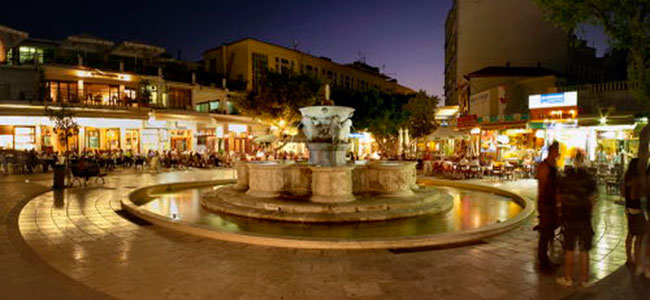
Old Town
The most notable monument along the harbor is the 16th-century Venetian Fort of Koules. Fishing boats line the shore, where a walkway runs along the waterfront. Across the road but fronting the harbor are the Venetian Arsenals, easily recognizable by the stone facade and huge archways. This is where the Venetians repaired their ships. To the west of the harbor, the scenic promenade stretches along the sea and is lined with seafood restaurants.The Oldown is protected by a circuit of massive defensive walls, which have been demolished in parts. Inside, its pedestrian-only streets are lined by aristocratic buildings, churches, and boutiques, and open onto leafy squares with fountains and busy cafés.
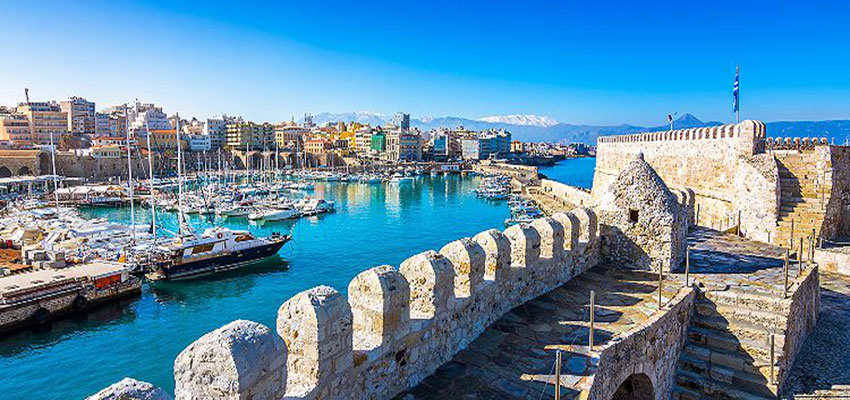
Koules Fortress
Koules is called the sea fortress built by the Venetians in Heraklion. It is located at the entrance of the Venetian harbor to protect the port of Heraklion and the Castle of Paleokastro in the Gulf of Ammoudara from the invasions and departures of other residents. It is also known as Castello del Molo, Rocca a Mare, Castle of the Sea, Castle of Candia or formerly Candelas (Castel di Candia).The present fortress was built between 1523 and 1540 at the site of an older chateau, which was deemed inadequate. Due to the wear and tear of the waves, it receives frequent repairs. However, despite the high maintenance costs, it played little role in the Ottoman occupation of Chandaka. During the Ottoman times it functioned as a prison and a small lighthouse was built there. Today it is accessible to the public.

Heraklion Archaeological Museum
The Archaeological Museum of Heraklion is the museum that presents almost all of Minoan civilization. It is one of the largest and most important museums in Greece and one of the most important in Europe [1]. Its exhibits include representative samples from all periods of Cretan prehistory and history, spanning approximately 5,500 years, from the Neolithic to the Roman times. Dominant in his collections are the unique masterpieces of Minoan art. The collection of Minoan antiquities is the most important in the world and the museum is considered to be the prime museum of Minoan culture.
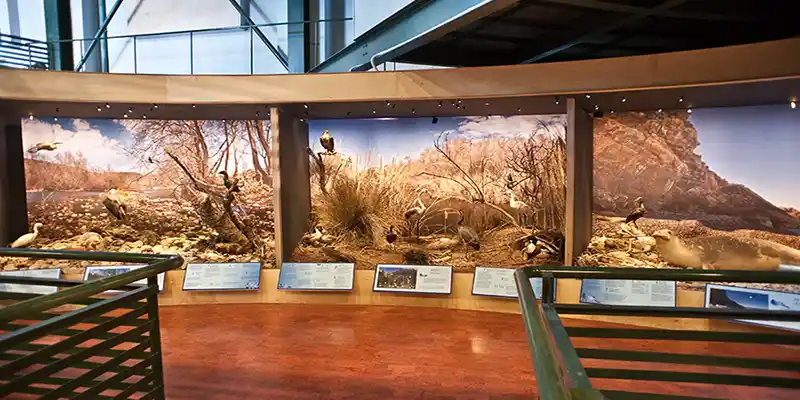
Natural History Museum of Crete
A visit to the Natural History Museum of Crete is an ideal thing to do for families. Situated right on the waterfront and just down from the Historical Museum, this is an impressive modern museum that showcases the best of Crete.Fun activities for children and adults include an earthquake and tsunami simulator. In addition, an entire floor is devoted to stuffed animals that live or once lived around the Mediterranean Sea. Make sure you try out the illusion exhibit. Also on display are artifacts from the Palace of Knossos. Displays have information in multiple languages. The building is bright and air conditioned, and makes for a good escape from the mid-day heat in Heraklion.

Historical Museum of Crete
With a succession of foreign occupiers, Crete's history is complicated but fascinating. This museum traces 1,700 years of history on the island, from early Christian times to the modern era.You'll see religious icons, stone carvings, ceramics, textiles, and folk costumes from the Byzantine, Venetian, and Turkish periods, as well as somber space dedicated to the Cretan Resistance Movement and those who lost their lives during WWII.Particular highlights include two paintings from the 16th century: The Baptism of Christ and the View of Mt. Sinai and the Monastery of St. Catharine.Everything is well presented and clearly labeled, and there's a peaceful garden café. You'll find it in a restored neoclassical mansion, a 10-minute walk west of the old harbor.

Cretaquarium Thalassocosmos
At this huge modern aquarium, you can see 2,500 marine species from the underwater world of the Mediterranean, swimming around in 1.7 million liters of seawater. A fascinating day out for kids and adults alike, it has 32 vast glass tanks displaying everything from hunter sharks to minuscule seahorses, jellyfish, turtles, lobsters, and octopus, all in beautifully-lit turquoise sea water against a backdrop of rocks, sand, and seaweed. The aquarium is located at a former American military base in Gournes, 13 kilometers east of Heraklion. A lovely on-site café with outdoor seating serves quick bites and cold drinks. Address: Gournes, 71003 Heraklion, Crete.
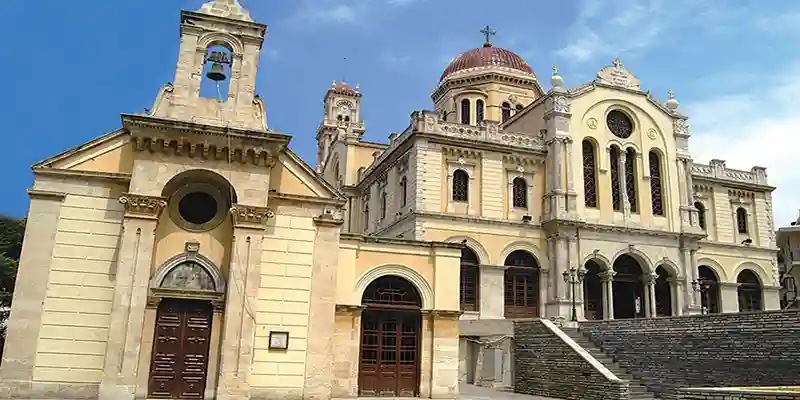
Cathedral of St. Minas
The Cathedral of Saint Minas is an Orthodox cathedral located in Heraklion and is the seat of the Archbishop of Crete.It was built on March 25, 1862 by the
Metropolitan of Crete Dionysius of Adrianople Thrace. Its construction was interrupted during the Cretan Revolution of 1866 and finally completed at the beginning of 1895. The
church was inaugurated on April 16, 1895 by Metropolitan Timothy I of Crete.The church is dedicated to Saint Minas, patron saint of Heraklion.The plan of the temple, as well as
its housing, refer to the cruciform inscribed with a dome and high drum. Internally, it combines elements of a three-aisled basilica, with porches on the north, south and west sides of
the P. The temple has a surface of 1,350 m2 and is the largest church in Crete and is considered (based on its basic sizes) and one one of the largest temples in Greece.
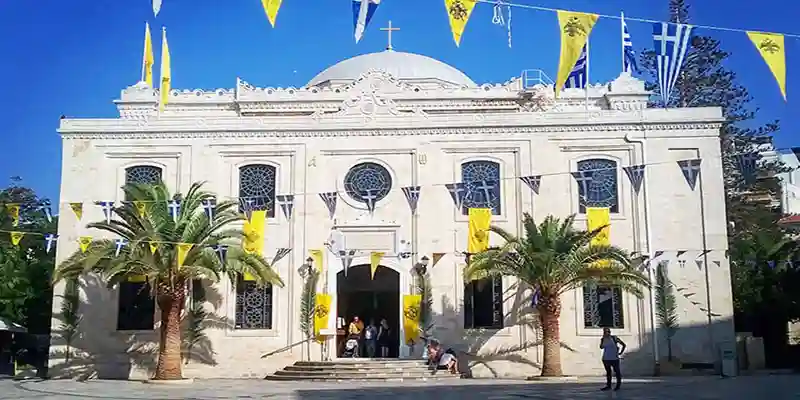
Agios Titos Church
The church of Saint Titus is an Orthodox church in Heraklion, Crete, dedicated to Saint Titus.
The present church was built in 1869 as the Yeni Mosque and in 1925 was dedicated to Christian worship. The church was
declared a cathedral of the Archdiocese of Crete in 2013. The building is an eclectic four-storey temple with a dome. On the
outer side of the temple are the vertical elements, while on the top there is a sculptured inscription.The present building
began to be constructed in 1869 under the design of Athanasios Mousi, who has designed, inter alia, the metropolitan church
of Saint Minas. The new mosque became known as the Yeni
Mosque, though it retained its old name. Following the accession of Crete to Greece and the exchange of populations,
the building was repaired by the Church of Crete and dedicated to Orthodox Christian worship on May 3, 1925. The minaret of
the mosque was demolished. On May 15, 1966 the temple of St. Titus from Venice was returned to the temple.From 1974 to
1988, the church was fortified and restored.In 2013, the church of Saint Titus was proclaimed by the Archbishop of
Crete The Pacific Cathedral of the Archdiocese of Crete.
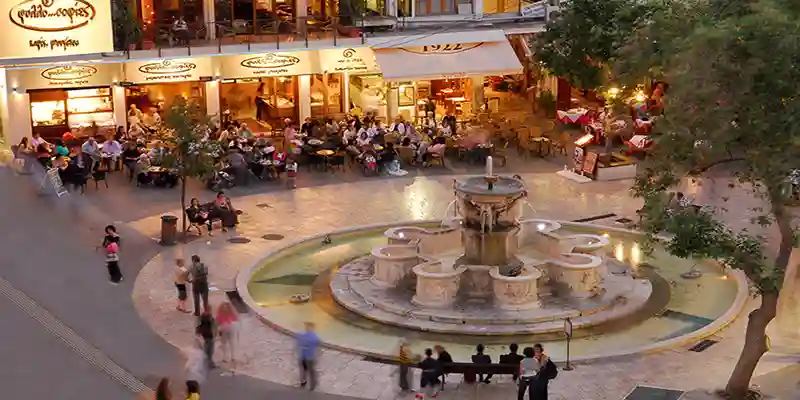
Morosini Fountain in Lion Square
The Morosini Fountain is located in Lions Square (Eleftherios Venizelos) opposite St. Mark's Basilica, in the center of Heraklion. It is
considered to be one of the most beautiful Venetian monuments of Chandakas (Name of Heraklion Crete during the Byzantine
period) and is preserved in very good condition. The reason for the construction was not aesthetics but the supply of
water to the city of Heraklion. The water was coming from the Yuchtas mountain in Archanes with a 15km aqueduct reaching
Heraklion.
Dating from 1628, this fountain, surrounded by mature trees and cafés, is the center of action in the old
city. When the weather is warm, you'll almost always find a lively scene of locals and tourists enjoying the surrounding
cafés and ice-cream shops. In the evening, the square around the fountain hums with people enjoying the nearby nightlife.
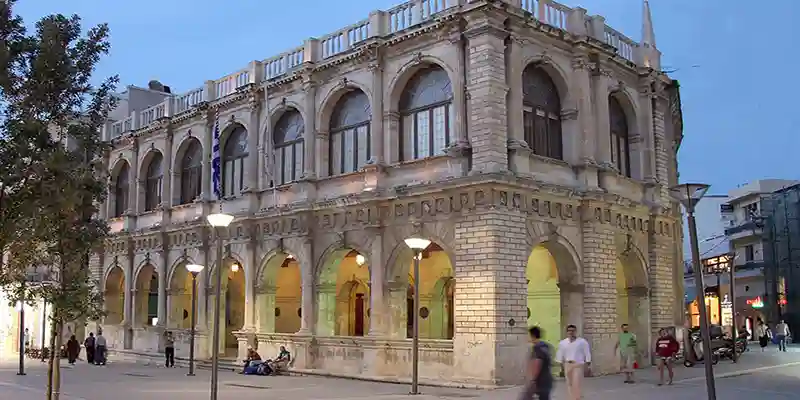
Loggia (Town Hall)
The building is located at the beginning of August 25th, at the intersection of St. Titus Street, near the Morosini Dam. Sample of Palladian rhythm, it is a rectangular building with dimensions 28m. for 11m, two-storey with Doric column on the ground floor and Ionic cones on the 1st floor. On the ground floor there is an apartment decorated with triangles and metopes with reliefs. The west side has seven pins with a central point to be used as an entrance.
Built by Morosini, the building dates from 1628 and is a reproduction of the famous Basilica in Vincenza, albeit on a much smaller scale.
Nearby is a wonderful area of narrow streets lined with restaurants with patios, as well as interesting shops.
Today it is the main building of the Municipality of Heraklion and houses the Mayor 's office, deputy mayors' offices, administrative and financial services and the hall where the Municipal Council meets.

Shopping in the Old Town
The Old Town of Heraklion has close to 1,000 shops, many of which are found in the extensive
maze of pedestrian-only streets. Located in among the narrow streets and alleys, you'll find lovely restaurants, hidden
patios, and retail shops selling pretty much anything you can imagine.
If you are on the hunt for the perfect souvenir
from Crete, head to the pedestrian-only 1866 Street, known as the Central Market. This narrow street is full of vendors,
with wares piled high and spilling out onto tables. You can find shirts, fridge magnets, jewelry, linens, and all manner
of kitsch for sale. If you have no room in your bags, don't worry, even luggage to transport all your new purchases is
available.
The shops, restaurants, and cafés are literally everywhere in the Old Town. Just pick a street and start
walking, take random turns, and you'll be amazed at what you discover.
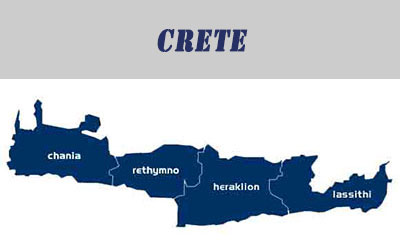
Ammoudara Beach
Only five minutes from downtown Heraklion is Ammoudara Beach. Small to medium sized
waves, perfect for bobbing about in, are usually common here as is a cooling breeze. Sun beds and umbrellas are free to use
if you purchase drinks or food from one of the roaming waiters. The beach is long and fairly wide, also perfect for
strolling.If the wind is up, this is one of Crete's most popular spots for kiteboarding. A kite school offering lessons
and rentals is located right on the beach should you wish to try your luck at this fast growing, adrenaline pumping sport.

El Greco Museum, Fodele
The Museum of Dominique Theotokopoulos (also known as the El Greco Museum is located
on the edge of the village of Fodele in Crete, west of the city of Heraklion.
The museum is about 1 km from the center
of Fodele, opposite a chapel and contains copies of works and documents related to Theotokopoulos. The original building was
in ruins but was rebuilt from 1982 onwards with a grant from the Ministry of Culture and Sports. The museum was opened to
the public in 1998. The village of Fodele is listed as the birthplace of Theotokopoulos, but this is disputed. The museum
claims to be located where Theotokopoulos was born.
The Historical Museum of Crete in Heraklion is not far away and
contains two original works by Theotokopoulos, the only original works of the artist in Crete.

Day Trip to Matala
Overlooking the Libyan Sea, 67 kilometers southwest of Heraklion, Matala is one of the most
visited resorts on Crete's remote south coast. Unlike places like Plakias, where tourists tend to spend several days or
more, Matala is more of a day-tripping destination and does not have much by way of seaside accommodation. Hotels and
other amenities are located in the town, back from the beach, although restaurants line the edge of the beach and one entire
side of the bay.Matala was made famous by the hippies in the 1960s, who lived here in the caves at the end of beach,
including Joni Mitchell, who even wrote about it in the song Carey. No one is certain how Matala's extraordinary caves were
made-some archaeologists believe they were Roman or early Christian tombs.

Day Trip to the Palace of Phaestos
It is located in the southwest of Heraklion, at a distance of 62
kilometers, at an altitude of 100 meters, south of the river Geropotamos and ancient Lithaios. The view of the hill is
panoramic and is surrounded by the imposing mountain ranges of Psiloritis, Asterousia and Lassithi Mountains, while the town
of Tympaki is within easy reach. An economic, administrative and religious center, it oversaw the fertile plain of Mesara.
The ancient ports of Matala and Kommos were under the control of Phaistos.
The first mention of Phaistos is made by Homer
in the Iliad and the Odyssey, where he mentions Phaistos in the list of cities that participated in the Trojan war and
describes it as a well-populated city. The ancient historian Diodorus Sikeliotis attributes the founding of Phaistos, as
well as of Knossos and Kydonia, to Minos. The views from the site are spectacular, and in the summer, it catches a blissful
cool breeze. Phaestos was abandoned around 1400 BC, about the same time as Knossos, and archaeologists still have a good
explanation for why. It lies 62 kilometers south of Heraklion, just a 15-minute drive from Matala.


